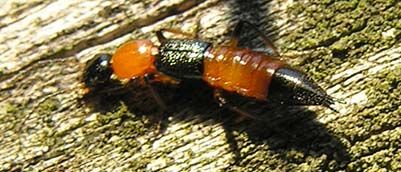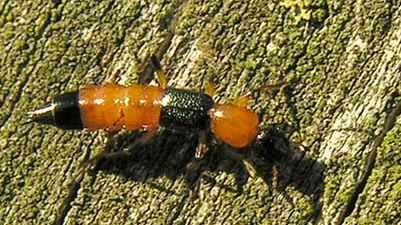Posted by Robert Heemskerk on 13-11-2005 19:04
#1
Hello Insectforum,
Today I found this insect, I can not find a name or even a familly-name for it..
Is it a Ocypus-species? or kind of Forficula?
Do you have any suggestion? please tell me.
regards Robert Heemskerk


Posted by Gerard Pennards on 13-11-2005 19:38
#2
Hello Robert,
This one is a rove beetle from the family Staphylinidae, so on Dutch "kortschildkevers"! The subfamily is Paederinae, and it's a species of Paederus!
Posted by Robert Heemskerk on 13-11-2005 19:54
#3
Thank you Gerard!, that is a quick reaction! :)
Could this Paederus be P. littoralis? (These species are rather common..)
Or does it have friends who look like it very much? (like riparius?)
I read that some beetles like these are poisonous!?;
''Only very few other beetles are quite as poisonous as the meloids. Small blue and red Rove Beetles of the widely distributed genus Paederus contain a powerful analogue of cantharidin, known as paederin. These beetles often fly into houses and may land and crawl upon the skin. If an attempt is made to brush off the insect, it may release the poison, causing painful blisters that take weeks to heal.''
and
""Pederin is a powerful toxin and DNA inhibitor circulating in the hemolymph of all developmental stages of some species of Paederus (Paederinae) and close allies in the subtribe Paederina. It is produced by endosymbionts in some, but not all, adult females, is transferred to eggs at oviposition, and thus to larvae and pupae. Males may obtain it by eating eggs. It is a defensive secretion active against spiders, but seems to have no insecticidal effect. It is a contender for the title of most powerful animal toxin. It produces dermatitis on human skin and severe damage to human eyes, but its therapeutic effects can be harnessed to heal chronic lesions in humans and cure cancerous growths.""
regards Robert,
Edited by Robert Heemskerk on 13-11-2005 23:35
Posted by topek on 25-09-2006 06:55
#4
Hi guys,
I have received many complaints from the public about the presence of Paederus sp. in their neighboorhood. I tried to explain to them about the life cycle of this species but I could not find any resourceful articles on this species especially depicting its larva and pupa stages. May someboody could help me.

